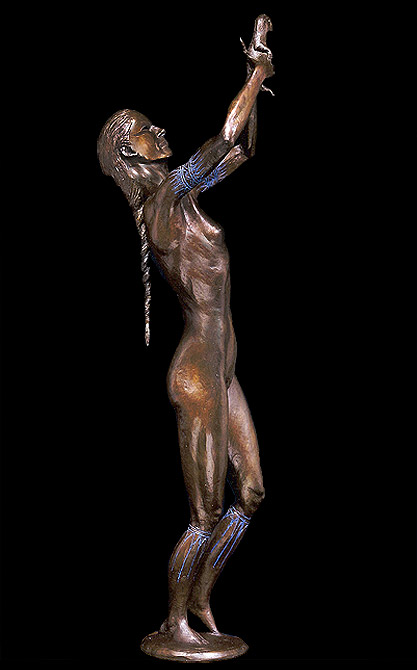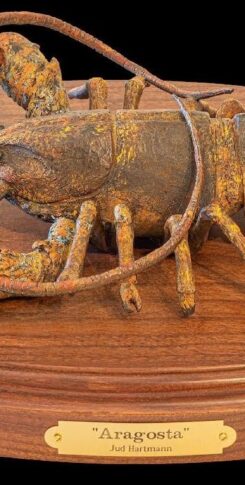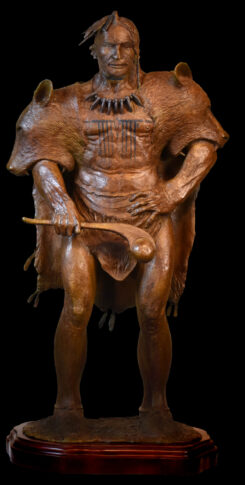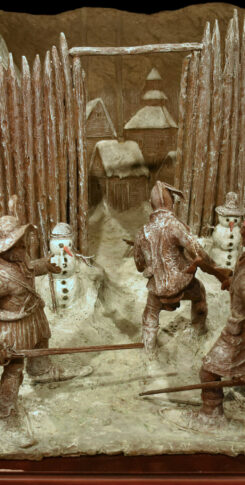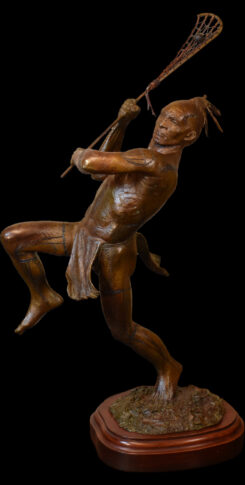a.k.a. Matoaka
Bronze edition: 10 | Height: 25″ (with base)
“A well featured , wanton young girl…resorting to our fort, of the age of 11 or 12 years,” where she would get the boys “forth with her into the marketplace, and vie with them in turning handsprings!”
William Strachey, 1608
“A child of tenne years old, which not only for features, countenance and proportion exceedeth any of the rest of her people, but for wit and spirit is the non-pareil of this country.”
Capt. John Smith, 1607
“Pocahontas” was a nickname which apparently well described her character, meaning, “playful one or frolicksome one.” Her given name was Matoaka or Matoax which means “little snow feather.”
Though there is some question as to the veracity of Smith’s famous account of the intervention of Pocahontas in saving his life, there is little doubt that as the colonists’ one real friend among the Powhatans, she was instrumental in saving the struggling colony of Jamestown from total destruction in its early years. Among those colonists there was one who was particularly taken with her. John Rolfes’ feelings were revealed in a letter to the governor of Virginia, Sir Thomas Dale: “I freely subject myselfe to your grave and mature judgement…my hart and best thoughts are and have byn a long time soe entangled and enthralled ( with Pocahontas)… lykewyse adding heereunto her great appearance of love to me (Is) her desyre to be taught and instructed in the Knowledge of God, her capableness of understanding, her good impression, and also the spiritual besides her owne incytements stirringe me upp hereunto. What should I doe?” In April, 1613 the two were married, ushering in a period of peaceful relations between the Powhatans and the English that lasted until 1622. In 1616 the couple and their entourage sailed for England.* Pocahontas proved to be a great sensation at the Court of James I and Queen Anne. She was christened “Lady Rebecca,” since she was after all considered of royal blood, being the favorite daughter, (one of 43 children), of Wahunsonacock, aka Powhatan, ” the Emperor of Virginia.”
While attempting to return to her native land, she took ill of a European disease. Wishing to console her grieving husband, she whispered with her dying breath: “that all must die, it is enough that the child lives.” She died on March 21, 1617 at Gravesend, England where she was buried. Her husband returned to Virginia, was credited with introducing Brazilian tobacco to the colony, but died in 1622. Their one son, Thomas was raised in England but returned to Virginia in 1635. He acquired considerable wealth and through his only daughter founded the Randolph family. In that line, as one 19th century geneologist observed: “…all the best families of Virginia may trace their descent…” among them the Lees, John Marshall, an early Chief Justice of the Supreme Court, Thomas Jefferson, the wife of Woodrow Wilson, etc.
“Poor little Maid. I sorrowed much for her thus early death, and even now cannot think of it without grief, for elt toward her as if she were mine own daughter.”
Captain John Smith, General Historie, 1624
* Among those in her retinue was one Tomocomo who was instructed by Powhaton to count all the people he saw in England. As soon as he arrived at Plymouth, he began making the count by notching a stick but soon abandoned the project because the people in England, he later reported to Powhatan, were as numerous “…as the stars in the sky, the sand on the beach, and the leaves on the trees.”

